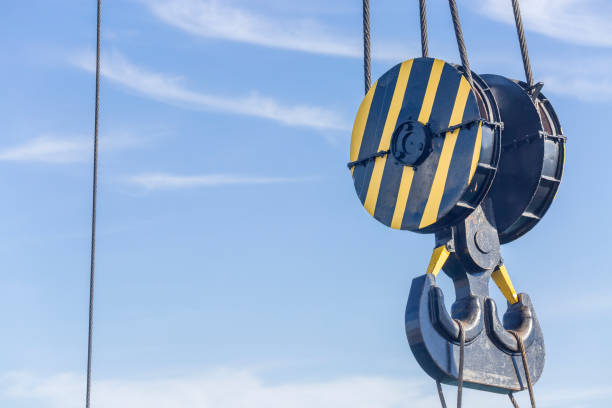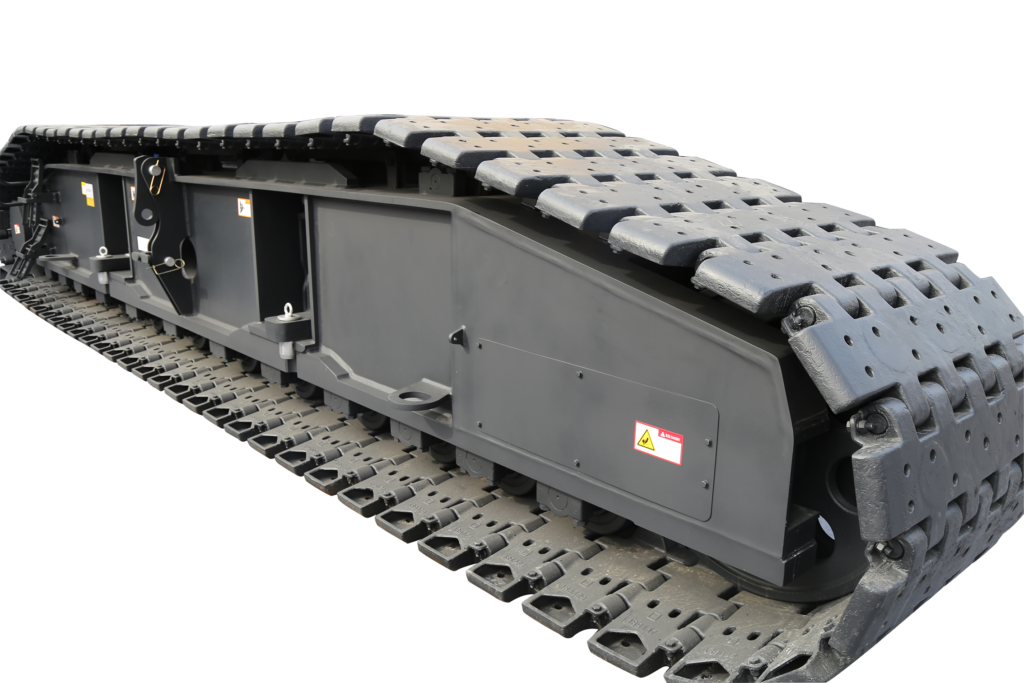When it comes to using a crane block, precision and safety are paramount. Proper knowledge and adherence to established procedures are crucial for successful and secure lifting operations. From assessing the load to inspecting the block and ensuring proper attachment, each step plays a vital role in maintaining stability and minimizing risks. By following a systematic approach and prioritizing safety protocols, operators can confidently utilize blocks to efficiently lift and maneuver heavy loads, promoting a safe and productive work environment.
the operating principle of a crane block
The operating principle of a crane block revolves around its ability to provide a secure attachment point for lifting loads. The block consists of a sheave or a set of pulleys mounted on a swivel hook. The hook block is connected to the crane’s hoist via a lifting cable or chain.
When the crane operator applies tension to the lifting cable or chain by operating the hoist mechanism, the load is lifted. The lifting force is transmitted from the hoist to the block, which redirects the force through the sheaves. The sheaves allow the lifting cable or chain to change direction while reducing friction.
By incorporating multiple sheaves, crane blocks can increase the mechanical advantage, allowing for greater lifting capacity. This principle is known as reeving, where the lifting cable or chain passes through the sheaves in a specific configuration to distribute the load evenly and maximize lifting efficiency.

The block’s swivel hook enables rotation, allowing the load to be positioned and maneuvered accurately. The hook block may also have a latch mechanism to secure the load during transport.
Overall, the operating principle of a crane block involves the transmission of lifting force through the sheaves, utilizing mechanical advantage and efficient load distribution to safely lift and move heavy loads with a crane.
how to use a crane block?
Here’s a step-by-step guide on how to use a crane block
step1: Assess the Load and Crane Capacity
Before using a crane block, assess the weight and dimensions of the load you need to lift. Verify that the crane’s capacity is sufficient to safely handle the load. Refer to the crane’s load chart and adhere to any relevant safety guidelines or regulations.
Step 2: Inspect the Crane Block
Before attaching the load, inspect the block for any signs of damage, wear, or deformation. Check the hook, sheaves, and any other components for cracks, corrosion, or other issues that could compromise its integrity. Ensure that the block is properly lubricated.
Step 3: Attach the Crane Block to the Crane
Position the block above the load and align it with the lifting point. Lower the block until the hook engages with the lifting point securely. If the block has a latch, ensure that it is properly engaged and locked.
Step 4: Apply Tension to the Load
Gradually apply tension to the load by operating the crane’s hoist mechanism. Lift the load smoothly and steadily, keeping a close eye on the load and the crane block to ensure stability. Avoid sudden movements or jerks that could put stress on the block or the load.
Step 5: Monitor Load and Block Movement
As you lift the load, monitor its movement and ensure that the crane block remains properly aligned. Watch for any signs of swinging, spinning, or other undesirable movements that may indicate an unstable load. Make adjustments to the lifting motion as necessary to maintain control and stability.
Step 6: Safely Position and Release the Load
Once the load has been lifted to the desired height and position, maneuver the crane to the intended location. Ensure that there is sufficient clearance and that the load is stable before releasing it. Follow proper signaling and communication protocols to guide the crane operator during the positioning and release process.
Step 7: Perform Post-Operation Inspection
After completing the lifting operation, inspect the crane block again for any signs of damage or wear that may have occurred during the lift. Lubricate the hook, sheaves, and other components as needed. If any issues are identified, report them to the appropriate personnel and take necessary corrective actions before the next use.

What's the difference between using a crane hook block and a crane snatch block?

The main differences between using a crane hook block and a crane snatch block can be summarized as follows:
Function and Purpose
A crane hook block is primarily used for direct lifting and suspension operations. Its main purpose is to provide a secure attachment point for the load and enable vertical or angular lifting.
A crane snatch block is designed to change the direction of a load or alter the lifting angle. It allows for redirecting the load path without moving the lifting equipment.
Load Path
When using a hook block, the load is lifted directly in a vertical or angled manner. The hook block may contain one or more sheaves or pulleys to facilitate smooth lifting operations.
A snatch block enables the operator to reroute the rope or cable through its sheave/pulley, creating a new load path. This allows for lifting in different directions or angles, including horizontal or diagonal pulls.
Mechanical Advantage
The crane hook block does not inherently provide a mechanical advantage. Its primary function is to provide a secure attachment point for lifting loads.
By reeving the wire rope or cable through multiple pulleys in a snatch block, the operator can create a mechanical advantage. This can reduce the required pulling force or increase the lifting capacity.
Applications
Crane hook blocks are commonly used in various lifting operations, such as construction, manufacturing, shipping, and material handling. They are suitable for lifting loads in a vertical or angular manner.
Snatch blocks find applications in scenarios where a change in lifting direction or angle is required. They are often used in rigging, recovery operations, or situations where loads need to be pulled at an angle or around obstacles.
how to reeve a crane block?
Step 1: Prepare for Reeving
Before starting, make sure you have all the necessary people, equipment, and materials required for the job. The crane should be fully assembled and operational, and the hook block should be positioned vertically on a stand in the same orientation it will hang on the hoist cable. Depending on the complexity of your crane, this process may require up to 10 people and can take several hours to complete.
Step 2: Thread the Cable Through the Upper Block Equalizer
Next, you'll need to run the crane's wire rope through the upper block equalizer sheave. The method you choose will depend on the cable's diameter. For smaller gauge cable, you can manually pull the cable over and through the upper block equalizer using a man lift. However, for heavier gauge cable, it's recommended to use a nylon rope. Tie the rope to the end of the cable and run it through the upper block equalizer sheave. You can then use the rope to pull the cable through the upper block equalizer using the crane's power.
Step 3: Secure and Join the Cable
After pulling the wire rope through the upper block equalizer, ensure that there's an equal length of cable hanging from each side of the sheave. Use a crosby clamp or another type of wire rope clip to temporarily join both sides of the cable near the upper block equalizer sheave. This step helps keep the cable in position and prevents anything from coming loose during the reeving process.
step 4: Reeve the Hook Block
Now it's time to begin reeving one side of the cable through the sheaves in your crane hook block. It's important to follow the specific reeving instructions for your particular hook block model, as Morgan offers a variety of styles and configurations. Incorrect cable routing is a common mistake during this step, so refer to the provided reeving diagram for guidance. If you have any questions about your specific application, reach out to a member of the Morgan Site Services team for assistance.
step 5: Attach the Cable to the Hoist Drum
Once you've properly reeved one side of the wire rope through the hook block, it's time to attach the cable to the crane's hoist drum. Clamp your cable to the man lift, ensuring there's a 15 to 20 ft. loop of cable hanging from the clamping point. Use the man lift to lift the cable end to the drum. At the drum, wrap the loose end of the cable around it 1.5 to 2 times before clamping it securely. This wrapping technique prevents excessive cable weight from hanging off the drum clamps. Make sure to tighten all cable clamps according to the manufacturer's specifications for your crane.
step 6: Repeat Reeving Steps for the Other Side
With one side of the cable attached to the drum, repeat steps 4 and 5 for the other side. Pay close attention to the cable routing through the crane block sheaves and ensure proper alignment.
step 7: Hoist and Verify Cable Movement
During the final stages of the crane block reeving process, slowly hoist the load to remove slack in the line. Multiple observers should monitor cable movement to prevent twists. Verify proper wire rope wrapping on the drum and confirm it falls into designated grooves. Ensure correct routing through the crane hook block and upper block equalizer sheaves. Pay attention to smooth movement and address any issues promptly.







